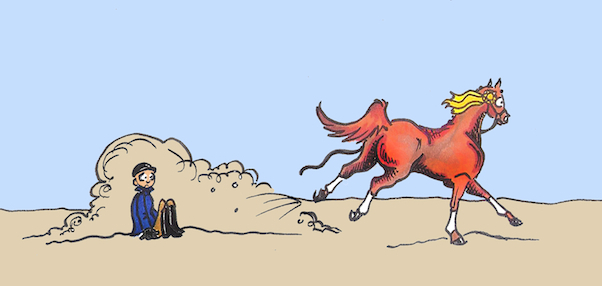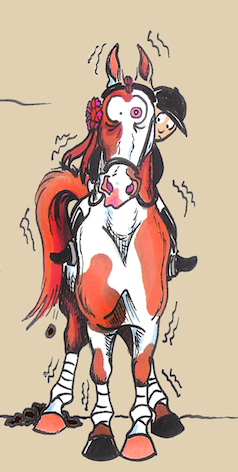
Ask the Equishrink: Getting Through an Instantaneous Panic Attack
Seana Adamson Ph.D, USDF Gold Medalist and equestrian sport psychologist, explains three things you need to know about your fear factor.
Illustrations by Morgane Schmidt of The Idea of Order. Check out a new comic by Morgane each Wednesday here on Horse Nation!
Question from a reader:
What are some strategies for getting through an instantaneous panic attack? I mean the ones that seem to come out of nowhere. I had a few bad falls off of my horse who on occasion bolts. I’ve been generally successful (albeit slowly!) working through my issues, but every now and again, without warning, I regress and am in full-blown anxiety mode. My trainer’s very patient, but for both our sakes, any tips you have would be most appreciated!
Seana’s response:
There’s nothing like a panic attack to ruin a perfectly good day. Once upon a time the panic response helped our paleo pals Gork and Gorka respond with lightning speed during a Saber Tooth Tiger attack. But now there is some debate in the neuroscience world about whether our finely tuned fear responses are too reactive for our relatively safe, modern world. Of course those doubting neuroscientists probably don’t have horses.
The athlete of all athletes, big wave surfer Laird Hamilton, believes that feeling fear is a normal and healthy part of the human experience. He says fear is good for the nervous system, good for metabolism, and good for keeping life in perspective. However he rides 70 foot waves so his perspective may be slightly skewed. It’s also worth noting that there is a difference between the performance enhancing adrenaline that Laird feels and the utterly incapacitating panic that you describe.
Anytime fear or panic interferes with your enjoyment then it’s time to get some help! I know there are many out there who share this experience with you so I’d like to give this important topic the attention it deserves. This week I’ll start by talking about how fear and panic occur in the brain. When you see what a primitive process panic is, it may help you begin to gain some perspective. Over the next few weeks keep looking for two or three more installments on this topic as I will give you some specific strategies and exercises to work with. To begin though, it is important to understand how your brain gets hijacked, so let’s start there.
HOW IT WORKS
As we go through our daily life there is a portion of your brain that is constantly scanning all of your senses for any sign of danger. It’s located towards the center of the brain and is called the Amygdala. The Amygdala is like your own little anti-malware program living inside your head. It scans sight, sounds, smell, touch, taste and kinesthetic (movement in space) information and when it senses a threat it lights up your fight or flight response immediately. At the same time the Amygdala blocks your rational mind from thinking because it knows you will run faster if you don’t think. This flight response proceeds to inoculate you with a massive cocktail of stress hormones and neurotransmitters. As a result your body is all set to run for its life, never mind that you’re sitting on a horse where it’s a bit inconvenient to start flailing around. A few seconds later (though it can feel like a few hours) your rational mind kicks in and tries to figure out what the heck just happened. Why is my heart racing? Why am I dizzy? How did I just forget my jump course, or dressage test? A panic attack can be completely disabling, totally embarrassing, and utterly confusing.
THREE THINGS TO KNOW ABOUT YOUR FEAR FACTOR
1. The Amygdala has an excellent memory. It constantly scans your world for any familiar threats and can respond to memories that you are not immediately conscious of. If you have crashed into a bright blue jump, your Amygdala may be extra sensitive to bright blue. If your horse freaked out when the neighbor’s dog jumped out of a bush then you may be extra sensitive to the presence of any dog, no matter how docile.
Imagine that your anxiety response is like a pail of water and when that pail overflows you feel a strong sense of panic. Your anxiety pail may overflow by a single stimulus. For instance if you had a bad experience at a mounting block, simply approaching the mounting block may be enough to trigger a sense of panic. If you have been in a war zone then any load noise such as a backfiring engine may flood you with panic. But sometimes our panic pail gets filled by the accumulation of several different factors. Maybe you hate blue jumps, and your horse feels tense, and you are tired and stressed from your day at work. All these factors fill your panic pail until suddenly it overflows and you’re in full blown panic mode.
Here is an actual example:
Carrie was driving home from a nice visit with her mother when she was suddenly flooded with extreme anxiety. She was on a quiet country road, following a lovely river, on a beautiful fall day when she suddenly felt so overwhelmed she had to pull over and calm down before she could drive further. It took a few minutes to figure it out, but suddenly she remembered that 30 years earlier she had been hiking a trail along that same stretch of river when two men had tried to chase her down to do God only knows what to her. She had managed to evade them and in the 30 years following had mostly forgotten about the incident. But on that day her Amygdala remembered. She had driven that road a hundred times over the last 30 years, so why did her Amygdala remember on this day? It was the same time of year with lovely golden colored trees, it was a similar time of day, and her fear response decided that was enough similarity to send out a warning alert.
2. Unfortunately sometimes the Amygdala is wrong. “Oops my bad! I thought that blue tarp looked just like the blue fence you crashed into last year. But hey, we lived through it so what are you complaining about?!” The Amygdala doesn’t care if panic is uncomfortable for you, it only cares that you survive the experience. As long as you stay alive the Amygdala is proud of itself for doing a good job. In fact it really doesn’t want you to think. If it had a motto it would be something like “Shut up and run!”
3. Sometimes the Amygdala is right to send you a warning. Sometimes it has some very valuable information to share. This creates a confusing situation where it is difficult to know whether you should listen or not. However there is no reasoning with the Amygdala once your panic pail has overflowed. At this point the Amygdala will actually block your higher thinking centers so reason flies out the window. As annoying as this may be, it can save your life in an extreme situation.
Once I was hiking in the hills behind my home in Reno, Nevada. I was peacefully marching along when suddenly I found myself falling backwards, landing with a thump on my derriere. A few feet ahead of me, where my next step would’ve landed, was a baby rattlesnake. We both skittered to safety, thankfully avoiding each other. Had I thought about how I was about to step on a baby rattlesnake, I would’ve been too slow to change my step. But the Amygdala blocked my thoughts and turned to a spinal reflex to save myself. Good little Amygdala!
Clearly there are times that the Amygdala has some very important information to share with you. That being said, if you tend to feel panic or extreme anxiety, it is important to listen to your Amygdala before your panic pail actually overflows. Once your pail overflows, there simply is no reasoning available to you. Over the next few weeks I will give you some ways to talk to your fear factor. You will have to learn to speak Amygdalese, so stay tuned for more ideas and techniques.
If you have any additional questions or comments, you can email me directly at [email protected] or visit my website www.seanaadamson.com
Seana Adamson Ph.D, is a psychologist specializing in Sport Psychology for equestrians. She is a United States Dressage Federation Gold Medalist, has been training dressage horses and riders for over 30 years, and is the author of “Memorize That Dressage Test: A workbook of mental games to improve focus and flow.” Learn more by visiting seanaadamson.com.








Leave a Comment